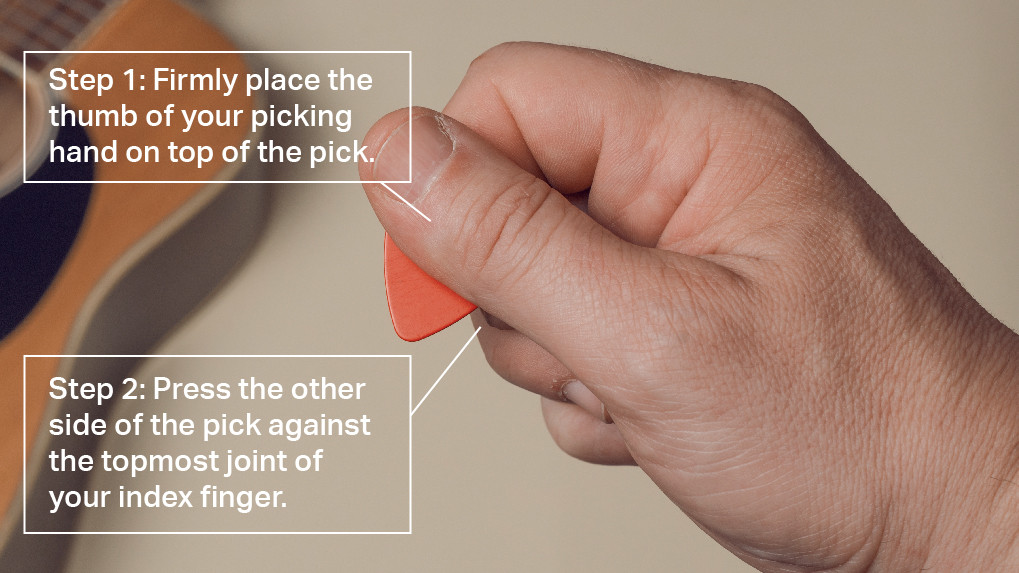Are you wondering What Guitar Pick To Use to unleash your musical potential? At guitarplayers.net, we understand that selecting the right plectrum is crucial for guitar players of all levels. This guide will help you find the perfect guitar pick, enhancing your guitar playing experience, whether you’re strumming chords or shredding solos.
1. What is a Guitar Pick and Why Use One?
A guitar pick, also known as a plectrum, is a small tool used to pluck or strum the strings of a guitar. Using a guitar pick enhances control, speed, and tonal quality compared to using bare fingers.
Expanding on this, a guitar pick provides a more consistent and focused attack on the strings. This leads to greater clarity and projection, particularly beneficial in genres like rock, metal, and bluegrass. Furthermore, using a pick allows for techniques such as alternate picking and sweep picking, which are difficult or impossible to execute with fingers alone. The versatility and precision offered by a guitar pick make it an essential tool for any serious guitarist looking to expand their skill set and explore different musical styles.
 Guitar pick close-up
Guitar pick close-up
2. Understanding Guitar Pick Thickness (Gauge)
What guitar pick thickness should I choose for my playing style? The thickness of a guitar pick, measured in millimeters (mm), greatly influences tone and playability.
Generally, thinner picks (0.4mm to 0.7mm) are ideal for strumming and rhythm playing due to their flexibility, producing a brighter, more delicate sound. Medium picks (0.7mm to 1.0mm) offer a balance of flexibility and control, suitable for both strumming and lead work. Thicker picks (1.0mm and up) provide greater precision and a bolder, more powerful tone, favored by lead guitarists and those playing heavier genres.
Here’s a table summarizing common guitar pick gauges:
| Gauge | Thickness (mm) | Best For | Sound Characteristics |
|---|---|---|---|
| Extra Thin | Under 0.45 | Light strumming, Ukulele | Bright, delicate |
| Thin | 0.45 – 0.70 | Strumming, Acoustic rhythm guitar | Bright, flexible |
| Medium | 0.60 – 0.80 | Versatile, Acoustic and Electric | Balanced, adaptable |
| Heavy | 0.80 – 1.20 | Lead guitar, Power chords | Bold, precise |
| Extra Heavy | Over 1.20 | Metal, Jazz, Fast picking | Powerful, articulate |
Keep in mind that these are guidelines, and personal preference plays a significant role. Experiment with different gauges to find what feels most comfortable and produces the sound you desire.
3. Exploring Guitar Pick Materials
What guitar pick material is best for different sounds? Guitar picks come in various materials, each offering a unique sound and feel.
Nylon picks are flexible and produce a warm, mellow tone, excellent for acoustic strumming. Celluloid picks, often associated with vintage tones, offer a balanced sound and comfortable grip. Tortex picks, known for their durability and consistent attack, are popular among rock and blues players. Metal picks provide a bright, aggressive tone, suitable for heavy metal and shredding. Wood picks offer a warm, organic sound, favored by jazz and acoustic players.
Consider the following:
- Nylon: Warm, mellow tone, flexible
- Celluloid: Balanced sound, comfortable grip
- Tortex: Durable, consistent attack
- Metal: Bright, aggressive tone
- Wood: Warm, organic sound
The choice of material should align with your desired tone and playing style.
 Different shapes of guitar picks
Different shapes of guitar picks
4. Guitar Pick Shape and Size Considerations
What guitar pick shape and size will enhance my playing technique? The shape and size of a guitar pick affect grip, control, and attack.
Standard picks are versatile and suitable for various playing styles. Jazz picks, smaller and more pointed, offer greater precision and control, favored by jazz and lead guitarists. Teardrop picks provide a balance of control and flexibility. Triangle picks offer three usable points, extending the pick’s lifespan.
When selecting a pick, consider the size of your hands and the level of control you need. Smaller picks are often preferred for intricate playing, while larger picks can be easier to grip for strumming.
5. Guitar Picks for Acoustic vs. Electric Guitars
Are there specific guitar picks for acoustic and electric guitars? Yes, the choice of guitar pick can differ based on the type of guitar.
For acoustic guitars, thinner to medium gauge picks (0.4mm to 0.8mm) made of nylon or celluloid are often preferred for strumming and fingerpicking styles. These picks produce a warm, balanced tone that complements the acoustic guitar’s natural sound. For electric guitars, medium to thicker gauge picks (0.7mm to 1.5mm) made of Tortex or metal are commonly used for lead work and heavier styles. These picks offer greater control and a more aggressive attack, ideal for solos and power chords.
However, these are general guidelines. Many guitarists use the same pick for both acoustic and electric guitars, adapting their playing style to suit the instrument.
6. How to Hold a Guitar Pick Correctly
What is the best way to hold a guitar pick for optimal control? Holding the guitar pick correctly is essential for control and comfort.
Hold the pick between your thumb and index finger, with only a small portion of the tip exposed. Maintain a firm but relaxed grip, avoiding excessive tension. Angle the pick slightly towards the strings for a smoother attack. Experiment with different grips to find what feels most natural and provides the best control for your playing style.
 Holding a guitar pick correctly
Holding a guitar pick correctly
Berklee College of Music recommends experimenting with various pick grips to find what feels most comfortable and allows for the greatest control and precision.
7. Mastering Picking Techniques
What are the key picking techniques to improve my guitar playing? Mastering various picking techniques will significantly enhance your guitar playing.
Alternate picking, using alternating upstrokes and downstrokes, is essential for speed and accuracy. Economy picking, minimizing unnecessary movement by using the most efficient picking direction, increases speed and fluidity. Sweep picking, using a continuous sweeping motion across multiple strings, is ideal for arpeggios and fast runs. Hybrid picking, combining pick and fingers, allows for complex and dynamic playing styles.
Regular practice of these techniques will build dexterity, speed, and control, allowing you to tackle a wider range of musical styles and challenges.
8. Common Guitar Pick Problems and Solutions
What should I do if I’m experiencing problems with my guitar pick? Addressing common issues can improve your playing experience.
If the pick slips from your fingers, try using a pick with a textured grip or applying a rubber grip. If your arm gets tired, relax your grip and focus on using smaller, more efficient movements. If the pick sounds scratchy, try using a different material or adjusting your picking angle. If you lose your pick inside the guitar, use a tool like a bent wire or specialized pick retriever to extract it.
Regularly inspect your picks for wear and tear, and replace them as needed to maintain optimal performance.
9. Guitar Pick Longevity and Maintenance
How long should a guitar pick last, and how do I maintain it? The lifespan of a guitar pick depends on several factors, including the material, thickness, and playing style.
Generally, a pick can last from several weeks to several months with regular use. To extend the life of your picks, avoid excessive force when strumming or picking, and store them in a case or holder to prevent damage. Clean your picks regularly with a soft cloth to remove dirt and oil, maintaining a good grip and preventing premature wear.
10. Best Guitar Picks for Beginners
What are the best guitar picks for someone just starting out? Selecting the right pick can make learning guitar easier and more enjoyable.
For beginners, thin to medium gauge nylon picks (0.4mm to 0.7mm) are often recommended. These picks are flexible and forgiving, making strumming and basic chord playing easier. They also produce a warm, mellow tone that is well-suited for acoustic guitars, which are commonly used by beginners. As you progress, experiment with different gauges and materials to find what suits your evolving playing style.
guitarplayers.net offers a wide range of beginner-friendly resources, including lessons, reviews, and community forums, to support your guitar-playing journey.
 Woman playing acoustic guitar
Woman playing acoustic guitar
11. Top Guitar Pick Brands and Models
What are some of the most popular and reliable guitar pick brands? Several brands are renowned for producing high-quality guitar picks.
Dunlop is famous for its Tortex picks, known for their durability and consistent attack. Fender offers a wide range of celluloid picks in various colors and gauges. D’Addario provides innovative picks like the Nylpro, combining nylon and polymer for enhanced grip and tone. Jim Dunlop and Clayton are also highly regarded for their diverse selection and quality craftsmanship.
Here’s a comparison of popular guitar pick brands:
| Brand | Popular Models | Material(s) | Key Features |
|---|---|---|---|
| Dunlop | Tortex Standard, Jazz III | Tortex, Nylon | Durability, consistent attack, precision |
| Fender | 351 Shape | Celluloid | Classic feel, versatile, wide range of colors |
| D’Addario | Nylpro | Nylon/Polymer | Enhanced grip, warm tone |
| Clayton | Acetal | Acetal | Bright tone, durable |
Choosing a reputable brand ensures you’re getting a reliable and well-crafted product.
12. The Influence of Guitar Pick on Tone
How does a guitar pick affect the overall sound and tone of my guitar? The guitar pick is an important factor in shaping your guitar’s tone.
A thicker pick generally produces a bolder, more powerful tone with increased sustain, while a thinner pick creates a brighter, more delicate sound with less sustain. The material of the pick also influences tone, with nylon picks offering a warm, mellow sound and metal picks providing a bright, aggressive sound. The shape of the pick affects the attack, with pointed picks offering greater precision and rounded picks providing a smoother sound.
Experimenting with different picks allows you to fine-tune your tone and achieve the sound you desire for different musical styles.
13. Using Guitar Picks for Different Genres
What types of guitar picks are best suited for various music genres? The choice of guitar pick can vary depending on the genre you’re playing.
For rock and blues, medium to heavy gauge Tortex or celluloid picks offer a balanced tone and good control. For metal, thicker gauge metal or hard plastic picks provide the aggressive attack and precision needed for fast riffs and solos. For jazz, smaller, pointed jazz picks made of nylon or Tortex offer greater control for complex chords and improvisation. For acoustic fingerstyle, thinner nylon or celluloid picks or even fingerpicks can provide a warm, delicate tone.
Consider these suggestions:
- Rock/Blues: Medium-Heavy, Tortex/Celluloid
- Metal: Heavy, Metal/Hard Plastic
- Jazz: Small, Pointed, Nylon/Tortex
- Acoustic Fingerstyle: Thin, Nylon/Celluloid
14. Guitar Pick Ergonomics and Comfort
How important is the comfort and feel of a guitar pick in my hand? Ergonomics and comfort are crucial for long playing sessions.
A pick that feels comfortable in your hand reduces fatigue and allows for greater control and precision. Consider the size, shape, and texture of the pick when evaluating comfort. Some picks feature ergonomic designs or textured grips to enhance comfort and prevent slippage. Experiment with different options to find what feels best for your hand and playing style.
15. Custom Guitar Picks: Are They Worth It?
What are the benefits of using custom-designed guitar picks? Custom guitar picks offer personalization and unique features.
Custom picks can be designed with specific shapes, sizes, materials, and graphics to suit your individual preferences and playing style. They can also be used for branding or promotional purposes. While custom picks may be more expensive than standard picks, they offer a unique and personalized playing experience.
Consider custom picks if you have specific requirements or want to express your individuality.
16. Storing and Organizing Guitar Picks
What are the best ways to store and organize my guitar picks? Proper storage keeps your picks organized and prevents damage.
Pick holders that attach to your guitar’s headstock or body provide convenient access during playing. Pick cases or pouches offer secure storage and protect picks from scratches and wear. Small containers or organizers can be used to sort picks by gauge, material, or brand.
Maintaining an organized pick collection ensures you always have the right pick for the job.
17. The History of Guitar Picks
What is the historical background and evolution of the guitar pick? The guitar pick has a rich history, evolving from natural materials to modern plastics.
Early guitar picks were made from materials like bone, wood, and tortoiseshell. In the early 20th century, celluloid became a popular material due to its affordability and flexibility. Today, a wide range of materials are used, including nylon, Tortex, metal, and various polymers.
The evolution of the guitar pick reflects the changing needs and preferences of guitarists across different genres and eras.
18. Guitar Pick Alternatives: Fingerpicking and More
What are some alternatives to using a guitar pick for playing the guitar? While picks are widely used, there are viable alternatives.
Fingerpicking, using your fingers to pluck the strings, offers a warm, intimate tone and allows for complex arpeggios and melodies. Hybrid picking combines pick and fingers, offering a versatile and dynamic playing style. Thumb picks, worn on the thumb, provide a percussive sound and are popular in country and bluegrass.
Exploring these alternatives can expand your playing techniques and tonal palette.
 Man playing guitar with a pick
Man playing guitar with a pick
19. The Future of Guitar Picks: Innovations and Trends
What new innovations and trends are emerging in the world of guitar picks? The guitar pick industry continues to innovate with new materials, designs, and technologies.
Some emerging trends include picks made from sustainable or recycled materials, picks with integrated electronics for tone shaping, and picks with advanced ergonomic designs for enhanced comfort and control. As technology advances, we can expect even more innovative and specialized guitar picks to emerge.
20. Finding Your Perfect Guitar Pick on guitarplayers.net
How can guitarplayers.net help me find the right guitar pick? guitarplayers.net offers a wealth of resources to help you find your perfect pick.
Explore our extensive collection of guitar pick reviews, comparisons, and buying guides. Join our community forums to connect with other guitarists and get personalized recommendations. Access our library of lessons and tutorials to learn how to use different picks and techniques. Stay up-to-date on the latest guitar pick innovations and trends.
guitarplayers.net is your ultimate resource for all things guitar.
Ready to find your perfect guitar pick? Visit guitarplayers.net today to explore our resources, connect with our community, and take your guitar playing to the next level! Address: 1140 Boylston Street, Boston, MA 02215, United States. Phone: +1 (617) 747-2261.
FAQ: Guitar Pick Selection and Usage
1. What is the most common guitar pick thickness?
The most common guitar pick thickness is medium, ranging from 0.60mm to 0.80mm, offering a balance of flexibility and control for various playing styles.
2. Can I use the same guitar pick for both acoustic and electric guitars?
Yes, you can use the same guitar pick for both acoustic and electric guitars, but consider the gauge and material to match the instrument and playing style.
3. How do I prevent my guitar pick from slipping?
To prevent your guitar pick from slipping, use picks with a textured grip, apply a rubber grip, or adjust your grip for a more secure hold.
4. What is the best guitar pick for fast picking?
The best guitar pick for fast picking is typically a small, pointed jazz pick made of a rigid material like Tortex or metal, offering precision and control.
5. How often should I replace my guitar pick?
You should replace your guitar pick when it shows signs of wear, such as rounded edges, chips, or loss of grip, to maintain optimal performance.
6. What is the difference between a celluloid and nylon guitar pick?
Celluloid picks offer a balanced sound and comfortable grip, while nylon picks are more flexible and produce a warmer, mellow tone.
7. Can the shape of a guitar pick affect my playing?
Yes, the shape of a guitar pick can affect your playing by influencing the attack, precision, and overall feel, with pointed picks offering greater control and rounded picks providing a smoother sound.
8. How does the material of a guitar pick affect the tone?
The material of a guitar pick affects the tone by influencing the brightness, warmth, and sustain, with metal picks providing a bright, aggressive sound and nylon picks offering a warm, mellow sound.
9. Is it better to hold a guitar pick loosely or tightly?
It is better to hold a guitar pick with a firm but relaxed grip, avoiding excessive tension that can cause fatigue and reduce control.
10. Where can I buy high-quality guitar picks?
You can buy high-quality guitar picks at music stores, online retailers, and directly from guitar pick manufacturers like Dunlop, Fender, and D’Addario, also check out the selection available at guitarplayers.net.
